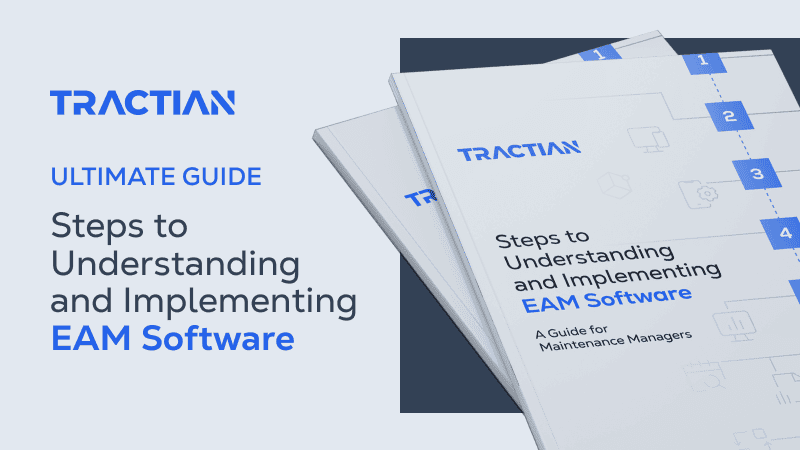In manufacturing, asset management is not a theoretical discipline or a corporate framework. It is the day-to-day practice of keeping machines running, controlling maintenance costs, and avoiding surprises that disrupt production.
Every plant depends on physical assets. Motors, pumps, conveyors, compressors, CNC machines, fans, and gearboxes directly determine throughput, quality, and safety. When those assets are not managed consistently, production suffers. Downtime increases, maintenance becomes reactive, and operators spend more time waiting than producing.
In many facilities, asset management is still fragmented. Maintenance history lives in a Computerized Maintenance Management System (CMMS). Condition data lives somewhere else or not at all. Operators know which machines are problematic, but that knowledge rarely makes it into planning or capital decisions. This disconnect is why many plants struggle to improve reliability even after investing in new tools.
Modern asset management in manufacturing connects equipment condition, maintenance execution, and asset history into one practical approach. The goal is simple. Fix the right equipment at the right time without disrupting production.
Key Takeaways
- Asset management in the manufacturing industry is about keeping equipment available, predictable, and cost-controlled across its entire life.
- Manufacturing asset management works best when condition monitoring, CMMS execution, and asset history are connected instead of managed in separate tools.
- Integrated asset management improves production efficiency for operators by reducing unplanned stops, emergency work, and last-minute schedule changes.
Why Manufacturing Asset Management Breaks Down
Most manufacturers do not fail at asset management because of effort. They fail because of structure and visibility.
| Area | Fragmented Asset Management | Integrated Asset Management |
|---|---|---|
| Maintenance Planning | Based on fixed intervals or past habits | Based on real asset condition and criticality |
| Downtime Response | Reactive and urgent | Planned and aligned with production schedules |
| CMMS Usage | Work orders created after failures occur | Work orders triggered by condition insights |
| Asset History | Incomplete, inconsistent, or outdated records | Continuous and accurate lifecycle tracking |
| Operator Experience | Surprise stops and last-minute schedule changes | Fewer interruptions and clearer priorities |
| Replacement Decisions | Driven by frustration, age, or repeated failures | Driven by performance, cost, and risk data |
| Multi-Plant Consistency | Each site manages similar assets differently | Standardized practices across plants |
These problems compound in asset-intensive manufacturing environments and become harder to manage as operations scale. The result is higher downtime costs, inconsistent execution, and frustrated operators.
The manufacturers that improve reliability do not add more processes. They connect the ones they already have.
Predictive Maintenance as the Starting Point
Predictive maintenance is one of the most effective ways to stabilize asset performance in manufacturing.
Instead of waiting for failures or relying only on calendar-based maintenance, predictive maintenance monitors how equipment is actually behaving. Vibration, temperature, runtime, and RPM data show early signs of mechanical problems long before a breakdown occurs.
For manufacturing teams, the value is practical:
- Fewer unexpected stops
- More time to plan maintenance around production
- Less emergency work
- Better use of maintenance labor
Predictive maintenance is especially important for critical and high-utilization assets. Bearings, motors, gearboxes, and rotating equipment often show clear warning signs weeks before failure. Sensors capture those signals continuously, even on variable-speed or intermittent machines.
When predictive insights are tied directly to maintenance workflows, teams stop arguing about when to act. The data makes the decision clear.
CMMS as the Execution Backbone
| Asset Management Capability | Primary Impact on Production |
|---|---|
| Predictive Maintenance | Prevents unexpected failures and emergency work |
| CMMS Execution | Keeps maintenance work organized, traceable, and on schedule |
| Asset Lifecycle Management | Supports repair versus replace decisions using real data |
| Real-Time Monitoring | Reveals idle time, hidden downtime, and utilization losses |
| Digital Models and Twins | Allows testing changes without disrupting production |
A CMMS is where asset management either works or breaks down.
In manufacturing environments, CMMS platforms manage work orders, preventive schedules, spare parts, labor, and asset history. But many CMMS deployments fail to deliver value because they operate in isolation.
When work orders are created without real condition data, teams either over-maintain or react too late. When asset history is incomplete, recurring problems go unresolved. When operators and technicians do not trust the system, compliance drops.
Modern CMMS software designed for manufacturing asset management connect directly to condition monitoring. Asset health alerts generate inspections. Inspections become work orders. Completed work updates asset history automatically.
This closed loop is what turns CMMS from a record-keeping tool into a production support system.

Managing the Asset Lifecycle in Manufacturing Plants
Asset lifecycle management helps manufacturers decide when to maintain, repair, rebuild, or replace equipment based on data rather than frustration.
Many plants keep problematic machines running far longer than they should because replacement decisions are hard to justify. Others replace assets too early without understanding true performance or cost drivers.
Lifecycle management connects:
- Maintenance history
- Failure frequency
- Downtime impact
- Operating conditions
- Total cost of ownership
With this information, manufacturers can compare similar assets across lines or plants, identify chronic issues, and plan replacements before failures become production events.
Asset disposition strategies for manufacturers work best when lifecycle data is consistent across sites. This reduces variability, improves standardization, and makes capital planning more predictable.
Real-Time Visibility into Utilization and Downtime
One of the most common questions manufacturing leaders ask is how to identify idle time and underutilized assets.
The answer is real-time monitoring tied to context.
Sensors and machine data show when equipment is running, stopped, or operating outside normal conditions. When this data is visible to operators and supervisors, it becomes easier to understand what is actually limiting production.
Real-time visibility helps teams:
- Identify hidden downtime
- Separate maintenance issues from production issues
- Improve shift handovers
- Reduce unplanned delays
- Improve operator accountability without adding manual reporting
This is where integrated asset management improves production efficiency for operators. Less guesswork. Fewer interruptions. Clear priorities.
Using Digital Models to Support Production Decisions
Digital twins and virtual asset models are becoming more common in manufacturing, especially for complex or high-value processes.
When connected to real asset data, digital models allow teams to test changes, evaluate bottlenecks, and understand performance limits without risking production. These tools support better asset production strategies and more informed process improvements.
Digital models work best when they are fed by accurate condition and maintenance data. Without that foundation, simulations remain theoretical and disconnected from reality.
Putting It All Together with Tractian

Manufacturers get the most value from asset management when condition monitoring, CMMS execution, and asset history operate as one connected system.
Tractian supports asset management in the manufacturing industry by combining industrial-grade sensors with a CMMS and AI-driven analytics in a single platform. Smart Trac Ultra vibration sensors continuously monitor vibration, temperature, runtime, and RPM, detecting early signs of mechanical issues and feeding actionable insights directly into maintenance workflows .
Because the platform is designed for fast deployment, manufacturers avoid long implementation timelines. Sensors install quickly, cellular connectivity removes IT bottlenecks, and mobile CMMS access supports work execution on the shop floor, even offline.
This approach helps manufacturers reduce unplanned downtime, improve repair speed, and lower inventory costs while creating consistent asset management practices across plants.
Tractian enables maintenance teams to move from reactive work to proactive, data-driven asset management. Request a demo to see how.
Asset Management in Manufacturing Industry FAQs
Can integrated asset management improve production efficiency for operators?
Yes. When asset condition, work execution, and downtime data are connected, operators experience fewer unexpected stops and clearer maintenance priorities. This reduces disruptions and improves line stability.
What is a realistic timeline for predictive maintenance across multiple plants?
Most manufacturers begin seeing actionable insights within weeks. Full deployment across several facilities typically takes a few months depending on asset count and rollout strategy.
What are the best asset management strategies for manufacturing teams?
The most effective strategies combine predictive maintenance, CMMS execution, lifecycle visibility, and real-time monitoring into a single, connected approach.
What industries or sectors benefit most from these asset management strategies?
These asset management strategies deliver value across virtually all manufacturing and industrial operations that rely on critical physical assets. Advanced maintenance approaches prove effective in food and beverage, automotive and parts, mining and metals, chemicals, mills and agriculture, oil and gas, and heavy equipment sectors. Beyond the facilities production environments, these strategies also optimize fleet operations. Any organization managing equipment where unexpected failures create operational disruption, safety risks, or financial losses can implement these strategies effectively, regardless of facility size or production volume.
What's the ROI timeline for implementing these strategies?
Typical payback periods range from three to twelve months, depending on facility size, asset criticality, and baseline maintenance maturity. Facilities that rely heavily on reactive maintenance often see faster returns. Timeline factors include deployment speed (such as using Tractian’s plug-and-play sensor installation), initial asset coverage, team adoption rates, and measurement rigor.
Can smaller facilities adopt these strategies, or are they only for large enterprises?
These strategies scale effectively to facilities of all sizes through cloud-based platforms that eliminate large upfront infrastructure investments. Smaller operations can start with high-impact assets rather than plant-wide deployment, installing sensors on critical equipment that drives the most production value or causes frequent disruptions. Advanced systems, like Tractian, deploy rapidly with sensors installing in minutes, cellular connectivity eliminating IT dependencies, and mobile apps working offline.


